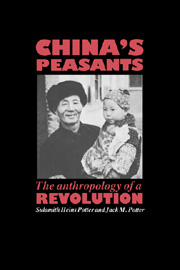Book contents
- Frontmatter
- Contents
- List of illustrations
- List of tables
- Preface
- Notes on the text
- Map 1 China
- 1 The old “feudal” order: Zengbu before Liberation
- 2 Establishing the new order
- 3 The ordeal of collectivization
- 4 The Cultural Revolution
- 5 Maoist society: the production team
- 6 Maoist society: the brigade
- 7 Maoist society: the commune
- 8 Impatient aspirations: transition to the post-Mao period
- 9 The cultural construction of emotion in rural Chinese social life
- 10 Marriage, household, and family form
- 11 Chinese birth planning: a cultural account
- 12 Lineage and collective: structure and praxis
- 13 Party organization
- 14 The party ethic: a devotion born of distress and enthusiasm
- 15 A caste-like system of social stratification: the position of peasants in modern China's social order
- 16 The Chinese peasants and the world capitalist system
- 17 The crystallization of post-Mao society: Zengbu in 1985
- References
- Index
7 - Maoist society: the commune
Published online by Cambridge University Press: 02 December 2009
- Frontmatter
- Contents
- List of illustrations
- List of tables
- Preface
- Notes on the text
- Map 1 China
- 1 The old “feudal” order: Zengbu before Liberation
- 2 Establishing the new order
- 3 The ordeal of collectivization
- 4 The Cultural Revolution
- 5 Maoist society: the production team
- 6 Maoist society: the brigade
- 7 Maoist society: the commune
- 8 Impatient aspirations: transition to the post-Mao period
- 9 The cultural construction of emotion in rural Chinese social life
- 10 Marriage, household, and family form
- 11 Chinese birth planning: a cultural account
- 12 Lineage and collective: structure and praxis
- 13 Party organization
- 14 The party ethic: a devotion born of distress and enthusiasm
- 15 A caste-like system of social stratification: the position of peasants in modern China's social order
- 16 The Chinese peasants and the world capitalist system
- 17 The crystallization of post-Mao society: Zengbu in 1985
- References
- Index
Summary
The commune in Maoist society must be understood in terms of its structure and organization, its role as a point of articulation between rural and urban levels of stratification, and its social significance in relation to the theoretical concept of the standard marketing area.
Chashan commune includes an area roughly 7 by 8 kilometers, and contains the old market town of Chashan and 45 surrounding villages (see map 4). In July 1979, Chashan commune had a population of 35,929 people: 4,000 lived in Chashan town, and the remaining 32,000 inhabitants were peasants who lived in the outlying villages and were organized into Chashan commune's 15 production brigades. The residents of Chashan town were legally urban residents, and constituted a caste-like status group distinguished legally from the peasants (see chapter 15). But the townspeople were not socially homogeneous. Town residents were differentiated by finelygraded prestige and status privileges. At the top were the state cadres and state workers who staffed the commune administration and state branch units in town. This category included the leading party functionaries, the managers of the grain purchasing station, the bank, and all other major state units. These state cadres and state workers drew higher salaries and enjoyed better health and retirement benefits than the local people. They could travel and be transferred to other towns and small cities, whereas the residence of ordinary town citizens who were not state cadres or workers was fixed in Chashan.
- Type
- Chapter
- Information
- China's PeasantsThe Anthropology of a Revolution, pp. 143 - 157Publisher: Cambridge University PressPrint publication year: 1990



